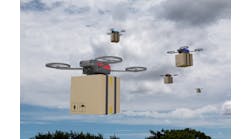Latest from Drones
North America Set to Lead in Drone Communication Industry
The drone communication market size is estimated to be USD 2.46 billion in 2024 to USD 3.67 billion by 2029, at a CAGR of 8.3%, according to a new report by MarketsandMarkets™. The drone communication market is growing rapidly due to better communication technology, increased use of UAVs in the military, and the need for secure data transmission. As drones are used more in defense, business, and industry, strong communication systems are needed for real-time control, better awareness, and successful missions. New technologies like AI-based communication, 5G networks, and encrypted data links are improving drone connectivity, making operations safer and more efficient. These factors are shaping the future of drone communication, making it an important part of unmanned aerial systems.
North America is set to lead the drone communication industry because of strong government support, advanced technology, and smart investments. The Federal Aviation Administration (FAA) has helped create clear rules under Part 107, making it easier for businesses to expand drone operations. The region's heavy investment in 5G networks and AI-driven systems has improved real-time data sharing, helping drones work more efficiently. The growing demand for autonomous drones in infrastructure inspection, precision agriculture, and defense is also boosting the market. The region benefits from a large defense budget and government-backed UAV programs, which support the development of drone communication technologies. A key example is the February 2025 partnership between Birds Eye Aerial Drones and ARTÉMIA Communications, showing North America's focus on improving drone communication for better safety, efficiency, and compliance.
Based on technology, the meshed network is expected to be the fastest-growing segment in the drone communication market during the forecasted period. Meshed network technology is changing drone communication by creating decentralized networks where each drone works as a node, sharing data across the system. Unlike traditional networks, meshed networks keep drones connected even in areas with little infrastructure. This makes them more reliable, scalable, and secure, which is important for defense, disaster response, and industrial operations that need real-time data sharing.
Meshed networks are the fastest-growing segment in drone communication because they support large-scale autonomous drone operations. AI-powered routing and adaptive frequency management help optimize data flow, ensuring smooth and secure communication in changing environments. As more industries use autonomous and team-based drone missions, meshed networks offer a strong and flexible communication system. Their ability to provide secure and high-performance connectivity makes them essential for the future of drone communication.
Based on application, the military segment is expected to be a leading segment in the drone communication market because it needs secure and fast data sharing for missions. Military drones are used in combat, intelligence, surveillance, reconnaissance (ISR), and logistics. In combat, encrypted signals and anti-jamming systems ensure safe communication for controlling drones, tracking targets, and guiding weapons without interference.
For ISR missions, drones use satellite communication (SATCOM) and tactical data links to send real-time intelligence, helping the military make quick decisions. In logistics, beyond visual line of sight (BVLOS) communication and autonomous networks allow drones to deliver supplies and help with medical evacuations in dangerous areas. As defense forces use AI and better communication systems, the military application continues to lead investments in drone technology. These improvements enhance coordination, security, and mission success, making the military application the top segment in the drone communication market.

